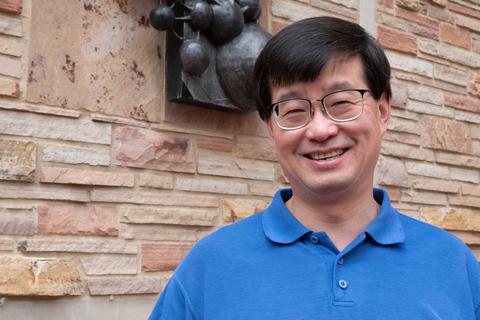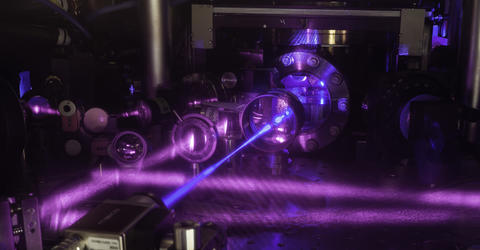
NIST/JILA physicist Jun Ye
Physicist Jun Ye has a knack for making every second count—literally. At JILA, a joint research institute of the University of Colorado and the National Institute of Standards and Technology (NIST), Ye and his colleagues recently built the world’s most precise clock—a device that would neither gain nor lose a second in 90 billion years, more than six times greater than the age of the universe.
For Ye, though, what matters just as much as the precision is the means of attaining it. Mirrors, miniature lenses, opto-electronic devices, and extraordinarily stable lasers: All of these must work in synchrony to build an atomic clock based on the oscillations of electrons orbiting the nucleus of individual strontium atoms.
Ye’s fascination with measuring tools dates back to his childhood. Born in Shanghai in 1967, Ye came of age at a propitious time in China: He was young enough to have escaped the Cultural Revolution’s destructive impact on schooling, yet old enough to reap the benefits of China’s revival of its national educational system.
Both of Ye’s parents had demanding careers—his father was a naval officer and his mother an environmental scientist and city official--and he often stayed with his paternal grandmother in Shaoxing, about 200 kilometers south of Shanghai. She had grown up during the hardship years of World War II and had never learned to read or write. Yet his grandmother gave Ye his first tools: a bundle of pencils and a stack of paper. Write down or draw anything you like, she told him.
In middle school and early high school, literature attracted Ye just as much as the sciences did. But during his formative years in the early 80’s, his mother gave him a set of books on the lives of great scientists. He read a biography about Carl Friedrich Gauss, the 19th century German mathematician and physicist. Gauss had not only calculated the orbit of the large asteroid Ceres, enabling astronomers to rediscover it after it had been lost in the sun’s glare, but invented his own tools to measure the curvature of the Earth.
While still in middle school, Ye got the chance to hold some of the measuring tools he had read about. He started building electronic circuits and measured the weight of objects with a balance scale. “I felt an amazing chill, realizing that the answers to scientific question could emerge from using those instruments,” Ye said.
During his freshman year in high school, Ye’s physics teacher noticed his aptitude and encouraged him to enter a physics competition. As part of the contest, he was tasked with repairing a faulty Wheatstone bridge, an electrical circuit with two branches. In order to measure the numerical value of an unknown resistor, the two branches must be exactly balanced so that they have the same voltage. Ye repaired the circuit and won the contest, propelling him towards a career in physics.
Although most of the courses Ye took at Shanghai Jiao-Tong University were in theoretical physics, for his undergraduate thesis he conducted research in an optics laboratory, working with lasers and optical fibers. His honors thesis advisor introduced him to new concepts in quantum theory while his laboratory studies earned Ye his first publication, in the journal Applied Optics. The next step seemed clear enough—conducting PhD research in physics at a prestigious university in China.
Ye was in Shanghai in June 1989, when student protestors seeking political reform gathered at Tiananmen Square in Beijing. In the aftermath of those protests, and as a young student holding high ideals, Ye decided to pursue his graduate studies in the United States.
At the University of New Mexico, he joined Marlan Scully’s group in quantum optics, conducting theoretical studies of how particles of light—photons--interact with atoms and molecules. Working with another professor, John McInerney, he conducted experiments with diode lasers to understand how the laser dynamics can be affected by external feedback. By the time Scully announced that he was moving to Texas A&M University in 1991, Ye had earned a master’s degree in physics and was searching for a place to continue his laboratory studies in quantum optics.
At a quantum optics conference in Snowbird, Utah, he met a demanding and hardworking experimental genius from JILA named Jan Hall, who had worked at NIST since 1961. Ye was immediately attracted to Hall’s working style and told Hall he wanted to join his research group for his Ph.D. thesis. Hall told him that he was brave to ask.
Ye and Hall were two of a kind. Each believed that new discoveries in physics would emerge as measuring tools were developed, refined, and perfected. And that if a tool failed to work the way it was supposed to, you might gain a new understanding of the laws of physics by fixing the problem.
Hall taught Ye to believe he could build with his own hands an instrument that measured a physical quantity better than any existing instrument. One just needed to work hard, think deeply, and come up with creative solutions.
Ye collaborated with Hall to develop the world’s most sensitive instrument for measuring the wavelengths and quantities of light absorbed by different molecules. In 1996, they built a sensitive device to measure the frequency of laser light. A year later, Ye completed his Ph.D., dedicating his doctoral thesis to his grandmother.
From there, Ye joined Jeff Kimble’s quantum optics laboratory at the California Institute of Technology in Pasadena. Kimble gave him a million dollars, an empty optical bench and a year to develop a system that would harness the interaction between light and atoms to trap individual atoms in a small cavity. Unsurprisingly, he met the challenge.

In 1999, Hall and his colleagues lured Ye back to JILA with Hall donating most of his laboratory space to his former student. Ye and Hall were both eager to examine how a device that Hall had recently co-developed might become a crucial missing ingredient for a new generation of atomic clocks. Called the optical frequency comb, the instrument acts as a ruler for light, measuring the colors, or frequencies, of light waves to exquisite accuracy. Many physicists consider the frequency comb to be the biggest revolution in precision measurements since the development of the laser in 1960. Hall shared the 2005 Nobel Prize in Physics for his discovery.
Ye, Hall and their colleagues have since worked to make the comb even more precise than it initially was. Ye’s team has also introduced frequency combs for a broad range of spectroscopy applications. Most recently, Ye’s research team used frequency comb technology to upgrade a breathalyzer so that it could detect the virus that causes Covid.
The comb enables scientists to translate higher frequencies, such as optical frequencies, which had been impossible to count because they are so rapid, to lower frequencies, such as microwave, which are easier to count.
The first atomic timekeeper, the microwave atomic clock, was developed in the 1950s and has defined the international standard (SI) for the second since 1967. It operates by shining microwave radiation (which ranges from 1 to 1000 billion cycles per second, or hertz), on cesium atoms. Radiation of exactly 9,192,631,770 hertz induces electrons orbiting the atoms to flip from one quantum state, known as spin, to another at highly regular intervals. The cesium clock keeps time based on this steady microwave frequency, similar to the way a grandfather clock marks time based on the swing of a pendulum.
NIST’s cesium atomic clock keeps time to within a second every 300 million years. However, the much higher-frequency optical atomic clocks developed by Ye’s team and other research groups are 100,000 times more precise and 100 times more accurate than the microwave atomic clocks and are now poised to replace them as the new time standard in the International System of Units.
Not content with that astonishingly high level of precision, Ye and his colleagues are working to produce an atomic clock that’s 10 to 100 times more precise in the coming decade. Such devices, if made portable, would open up new vistas for discovery. They could hunt for the ripples in space-time known as gravitational waves without the massive, kilometers-long arrays of optics now needed to detect them and provide a new way to search for dark matter, the invisible material whose gravity keeps galaxies from falling apart.
The clocks could also lay the foundation for more accurate GPS and deep-space navigation and might offer clues for elucidating one of the biggest mysteries in all of physics: how to unify two highly successful but seemingly incompatible theories--Einstein’s theory of gravity and quantum mechanics.
One day in the not-too-distant future, said Ye, miniature versions of these clocks will be launched into space, exploring new frontiers in the quest to understand the universe.
-- Written by Ron Cowen

